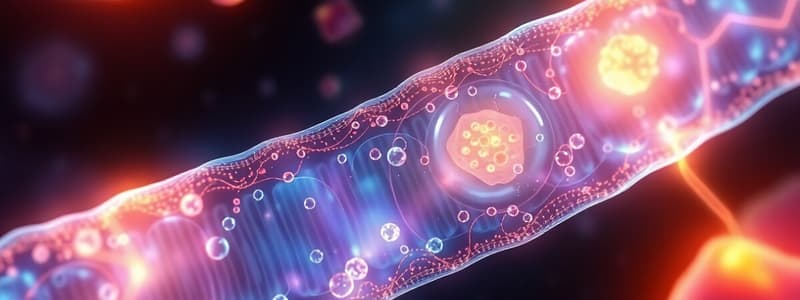Podcast
Questions and Answers
Which type of lipid is most prevalent in cell membranes?
Which type of lipid is most prevalent in cell membranes?
- Fatty Acids
- Phospholipids (correct)
- Sterols
- Triglycerides
What percentage of the cellular membranes is estimated to consist of lipids?
What percentage of the cellular membranes is estimated to consist of lipids?
- 30%
- 50% (correct)
- 70%
- 90%
Which of the following lipids is primarily associated with energy storage?
Which of the following lipids is primarily associated with energy storage?
- Triglycerides (correct)
- Cholesterol
- Glycolipids
- Phospholipids
Which lipid type is involved in membrane fluidity and stability?
Which lipid type is involved in membrane fluidity and stability?
Which lipid can form a bilayer that is crucial for forming cellular structures?
Which lipid can form a bilayer that is crucial for forming cellular structures?
What movement occurs within the cell during signal transfer?
What movement occurs within the cell during signal transfer?
What interaction is mentioned as being significant to the bilayer structure?
What interaction is mentioned as being significant to the bilayer structure?
How do the self-assembling properties of lipid bilayers affect cellular function?
How do the self-assembling properties of lipid bilayers affect cellular function?
What is a characteristic feature of a bilayer membrane?
What is a characteristic feature of a bilayer membrane?
Which factor primarily drives the formation of lipid bilayers?
Which factor primarily drives the formation of lipid bilayers?
Flashcards
Phospholipids
Phospholipids
Common lipids found in cell membranes and organelle membranes.
Cholesterol
Cholesterol
Another type of lipid found in cell membranes.
Glycolipids
Glycolipids
Lipids with attached carbohydrate chains.
Cell Membranes
Cell Membranes
Signup and view all the flashcards
Organelle Membranes
Organelle Membranes
Signup and view all the flashcards
Membrane Movement
Membrane Movement
Signup and view all the flashcards
Self-Assembly
Self-Assembly
Signup and view all the flashcards
Hydrophobic Interactions
Hydrophobic Interactions
Signup and view all the flashcards
Cell Membrane Bilayer
Cell Membrane Bilayer
Signup and view all the flashcards
Signal Transduction
Signal Transduction
Signup and view all the flashcards
Study Notes
Plasma Membrane Structure
- The plasma membrane is a fluid mosaic model
- Composed of phospholipids, proteins, and carbohydrates
- Phospholipids form a bilayer with hydrophilic heads and hydrophobic tails
- Proteins are embedded within the bilayer, some spanning the entire membrane (transmembrane), others are on the surface.
- Carbohydrates are attached to proteins or lipids, primarily on the extracellular side, forming the glycocalyx.
- Cholesterol is a component of animal cell membranes, contributing to membrane fluidity.
Membrane Lipids
- Phospholipids are the most abundant lipids in the membrane.
- Phospholipids include phosphatidylcholine, phosphatidylethanolamine, phosphatidylserine, phosphatidylinositol, and sphingomyelin
- Glycolipids are found almost exclusively on the exterior, non-cytoplasmic face of the plasma membrane.
- Glycolipids are comprised of a carbohydrate portion and a lipid portion
- Cholesterol is another major lipid component in animal cell plasma membranes.
Membrane Proteins
- Integral membrane proteins are embedded in the phospholipid bilayer and may span the entire membrane.
- Peripheral membrane proteins are associated with the surface of the membrane.
- There are several types of membrane proteins that serve diverse purposes in cellular processes.
- Transmembrane proteins have a significant role in transport.
- Proteins associated with the bilayer may consist of the beta-barrel, alpha-helix, and pleated-sheet structures.
Membrane Fluidity
- Membrane fluidity is influenced by lipid composition and temperature.
- Unsaturated hydrocarbon tails with kinks reduce interactions and increase fluidity, while saturated tails are more rigid.
- Cholesterol moderates the effect of temperature on membrane fluidity.
Membrane Transport
- Passive transport occurs down the concentration gradient (from higher to lower concentration). This requires no energy from the cell.
- Simple diffusion occurs without any membrane protein assistance.
- Facilitated diffusion uses channel or carrier proteins to transport molecules across the membrane.
- Active transport moves molecules against the concentration gradient, requiring energy (often from ATP).
- Passive transport methods include simple diffusion and facilitated diffusion.
- Active transport methods include uniporters, symporters, and antiporters.
Membrane Functions
- Transport: Movement of substances into and out of the cell (passive and active).
- Enzymatic activity: Carry out metabolic reactions.
- Signal transduction: Receive and transmit signals.
- Cell-cell recognition: Allows cells to identify each other.
- Intercellular joining: Cells join at points of contact.
- Attachment to the cytoskeleton and extracellular matrix (ECM): Provides structural support and anchors cells during processes.
Membrane Specializations
- The glycocalyx, on the exterior, has significant roles including cell-cell recognition, protection, and cell adhesion.
- Lipid rafts are localized regions of the membrane due to the composition of cholesterol and glycosphingolipids. These likely play a critical role in signaling and transport.
- Membrane compartmentalization and transport are very important factors in maintaining the function of the cell.
Endocytosis and Exocytosis
- Endocytosis is the process of taking in large molecules and particles.
- Phagocytosis takes in solid particles, while pinocytosis takes in fluids.
- Exocytosis is the opposite process, releasing large molecules or particles from the cell.
Studying That Suits You
Use AI to generate personalized quizzes and flashcards to suit your learning preferences.




